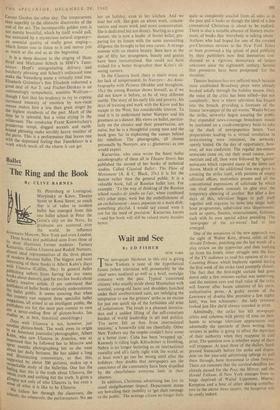Ballet
The Ring and the Book
By CLIVE BARNES
Si. Petersburg or Leningrad, Maryinsky or Kirov, Theatre Street or Rossi Street, so much that is of value in modem ballet has emerged from this one ballet school in Peter the Great's city on the Nova. Its graduates are scattered over . Three books just published stern from three of its most illustrious former students: Tamara Karsavina, Galina Ulanova and Rudolf Nureyev, almost ideal representatives of the three phases Of modern Russian ballet. The biggest and most interesting of these books is Albert Kahn's Days With Ulanova (Collins, 50s.). In general ballet publishi
ns suffers from having far too many ?ooks about dancers, and far too few books about ballet's creative artists. (I am convinced that Publishers of ballet books seriously underestimate the ballet public. It seems amazing that when this country can support three specialist ballet
Magazines, all aimed at an intelligent public, the PUblishers are for the most part content to turn
never-ending flow of picture-books, fan studies or, at best, historical anecdotage.) Days with Ulanova is not, however, just ;41°ther picture-book. The work owes its origin an American journalist/photographer, Albert Is.ahrt Who saw Ulanova in America, was so smpressed that he followed her to Moscow and
1,3ent months photographing her as. she went
about her daily business. He has added a long
illuminating lluminating commentary, so that this, 1113Ported by about 300 pictures, makes up a 7M.arkable study of the ballerina. One has the ling that this is the truth about Ulanova, the nole truth and nothing but the truth. It gives a
sense of only of who Ulanova is, but even a "nse of what it is like to be Ulanova.
s_,We follow her through the classroom, the cnnols, the rehearsals, the performances. We see
her on holiday, even in her kitchen. And we hear her talk. She goes on about work, concen- tration and more work and more concentration. She is dedicated but not dreary. Starting as a great dancer, she is now a leader of Soviet ballet, pre- paring for its future with the same unremitting diligence she brought to her own career. A strange woman with an elusive beauty. Seen here at the age of fifty her strangeness, beauty and genius have been immortalised. She could not have wished for a better biographer than Kahn's all- seeing camera.
In the Ulanova book there is much stress on her lack of temperament. In Nureyev : An Auto- biography with Pictures (Hodder and Stoughton, 35s.) the young Russian shows himself, as if we did not know it before, to ba of very different mettle. The story of his early life and poverty, his days of training and work with the Kirov and his escape to the West, has considerable interest. To read it is to understand better Nureyev and his greatness as a dancer. His views on ballet, particu- larly on the classics and their preservation, are naive, but he is a thoughtful young man and the book goes far in explaining the causes behind his rebellion. The photographs, all chosen personally by Nureyev, are r.; glamorous as one would expect.
Karsavina, who once wrote the finest ballet autobiography of them all in Theatre Street, has published the second of her books of technical studies. Called Classical Ballet : The Flow of Movement (A. & C. Black, 25s.) it is for the dancer rather than the general public. It is a valuable book, full of Russian ballet lore. For example: 'To the way of thinking of the Russian school rondes de jambe en fair, when combined with other steps, were but the embellishment of an enchainement : sauce piquanle to a main dish; something playful. I would say casual were it not for the need of precision.' Karsavina knows —and her book will still be valued many decades hence.






























 Previous page
Previous page